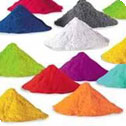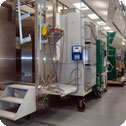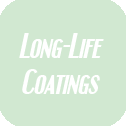About Powder Coating
Powder Coating
Powder coating is a dry film process, using finely ground particles of pigment and resin which are electrostatically charged and sprayed onto electrically grounded parts to be coated.
The charged powder particles adhere to the parts and are held there until melted and fused into a uniformly flowing coating in a cure oven.
Before coating, the parts must be pretreated similar to liquid coated parts.
Powder coat such as Akzo Nobel's Interpon D3000 that contain 70% of fluorocarbon resin in polymer matrix and PPG's Duranar powder coat that combines proprietary resin and pigment technologies with 70% of the resin system being fluoropolymer base resins offer good choices for high-performance AAMA2605 powder coat.
The exact composition of a particular powder coating is often complex and proprietary. In general most powder paints contain resins, pigments, fillers and additives.
Resin System: Resins are the key component of powder coatings. The range of powder coat resins used have increased to meet the demands the architectural market sector. Resin systems include: Kynar (PVDF), Polyester, Super Durable Polyesters, Urethane, Epoxy, Acrylic, and Nylon.
Pigment: Pigments are the material added to the paint to give it color or to enhance certain physical properties of the coating. The selection of pigments is done on the basis of physical needs, durability, gloss, color fastness and chemical exposure. Pigments are both naturally occurring as well as synthetic. Typically solid particulate materials such as titanium dioxide or carbon black.
Fillers: Used to reduce cost of the coating formulation and to improve specific properties such as flow, surface texture, lubricity, etc. Common fillers include barytes, calcite, mica, talc, whiting and wollastonite.
The raw powder coatings, composed of resin, pigment, curing agent and fillers are mixed dry and then melt mixed and extruded. once cooled, the mixture is chipped and ground into finely divided particles. The chips are ground to a very specific particle size distribution depending on the application.
The particle size is important to the performance and appearance of the coating. The size of the powder particle can have an influence on the behavior of the material in the painting process and the final film characteristics.
All powder coat paints are formulated and created by the manufacturer at their facility, there is no in-house blending of powder coatings.
Powder coatings are electrostatically applied, dry coatings. Powder coatings contain no solvents, and the process emits negligible, if any, volatile organic compounds (VOC) during application.
The powder coat industry has made steady advances in technology to reach architectural performance requirements.
The performance strengths and limitations of architectural powder coat are summarized as follows:
Strengths of Powder Coat
Limitations of Powder Coat
Powder Coat Overview
The primary component of powder coat is referred to as the resin. The type of powder coat system comes from the resin system. The powder coating formulation is much like a liquid coating except that most of the components are in solid, melt processable form.
Powder Coat Questions
Architectural Powder Coat
 Formulation of Paint
Formulation of Paint
Therefore lead-time of samples and color matches are greatly increased from that of liquid Kynar paint matches.
 VOC Free
VOC Free
 High-Performance Kynar Powder Coatings
High-Performance Kynar Powder Coatings
Many powders are available that meet AAMA 2604 and AAMA 2605 requirements, there are also Kynar 500 based powders that have excellent performance.
Strengths & Limitations
Brochures | 3-Part CSI specifications | CAD details
Source: https://linetec.com
05 05 13 - Shop-Applied Coatings for Metal
09 96 56 - Epoxy Coatings

